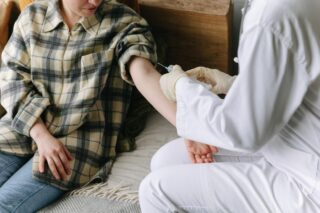Certain cancer screening types, including mammograms and colonoscopies, are well-known among patients. But lung cancer screening isn’t one of them—and even high-risk patients aren’t getting the message.
More than half of current smokers—54%—know little or nothing about lung-cancer screening, according to recent data from Phreesia Life Sciences, which surveyed more than 14,000 current and former smokers as they checked in for doctors’ appointments. And only 28% of survey participants with any smoking history—many of whom also are considered high-risk—said they were aware of lung-cancer screening.
Early detection in lung cancer is key to better chances of survival, which makes the survey figures particularly alarming. Patients who are diagnosed when their cancer is still localized to the lungs have a five-year survival rate of 61.2%, according to data from the National Cancer Institute. But that rate nosedives to just 7% for patients whose cancer has spread to other parts of their body before it’s detected.

So what can pharma marketers do to help? For starters, getting the word out about who should be screened—to both patients and doctors—is critical. Just last year, the U.S. Preventive Services Task Force expanded screening recommendations to include adults ages 50 to 80 who have a 20 pack-year smoking history and either currently smoke or have quit within the past 15 years.
Now, “doctors just don’t know about it. They don’t talk about it,” Heather Kun, CEO of nonprofit Fuck Cancer, says. And on top of that, “the criteria for being screened is beyond complicated,” she notes, pointing to the pack year count.
Patients need more education around the screening itself, too, explains Nancy Ibach, associate vice president of U.S. Oncology at Merck. Screenings consist of low-dose CT scans, and “people realizing that it is not an invasive procedure … could actually help us help others,” she says.
And he way pharma marketers communicate that information is important, Kun adds. “Make it funny, make it lighter,” she suggests. “This isn’t a big deal—you’re getting your picture taken!”
But boosting awareness alone won’t solve the problem, Phreesia survey data shows. Of the 28% of current or former smokers who said they were aware of screening, just 5% have been screened for lung cancer in the past 12 months, and only 11% plan to be screened in the next 12 months. Those stats suggest there are other hurdles to screening that marketers must address.
For one, smokers and former smokers may experience feelings of guilt or shame that stop them from getting screened. “There’s a lot of guilt, if you will, a lot of, ‘I did this to myself,’ and sometimes that can impact their ability to even undergo the screening,” Ibach says.
In some cases, those feelings may stop them from even sharing their smoking history with their doctors, Kun adds. Destigmatizing the conversation around smoking can help ensure that patients and providers can have open, honest conversations. “It’s super important to get people out of the dark to say, “‘I’m owning my risk factors,’” she says.
Patients in underserved communities may also face additional barriers, leading to later diagnoses and worse fatality rates. Currently, screening isn’t accessible enough for all patients, says Kun, who suggests expanding the technology to a certain number of community health centers per zip code.
Patients in these communities can also be less trusting of physicians, Ibach says. “We have to get into the community with the message, and we have to partner with people who can get into the community and deliver this message from a trusted source who can help them understand the details of it,” she notes.
While the challenge of upping screening rates is a big one, it’s one that comes with the opportunity to save patients’ lives, Ibach says.
“We’ve got a lot of education to do, but I do think if we as an industry within the pharma space can create more awareness, we can really change health outcomes within this particular diagnosis.”





 As out of pocket healthcare costs grow, consumers and patients are sometimes faced with the challenge of being able to afford and take their medication as prescribed. Within the past two years, dermatologist Dhaval Bhanusali, MD, FAAD had a situation where he had prescribed an anti-fungal cream to a patient. In a follow-up, he discovered that a treatment that should have cost her less than $8 ended up costing $1,200.
As out of pocket healthcare costs grow, consumers and patients are sometimes faced with the challenge of being able to afford and take their medication as prescribed. Within the past two years, dermatologist Dhaval Bhanusali, MD, FAAD had a situation where he had prescribed an anti-fungal cream to a patient. In a follow-up, he discovered that a treatment that should have cost her less than $8 ended up costing $1,200. The medical entrepreneur had previously launched a platform to compare prices between different local pharmacies as well as an EMR platform for Dermatologists and even helped launch Amazon’s first private skincare brand. Skin Medicinals, an online platform that utilizes compounding pharmacies to specially mix medications for patients, emerged as a result of that work. Dr. Bhanusali is also an instructor in the Mount Sinai Health System and works in private practice in NYC.
The medical entrepreneur had previously launched a platform to compare prices between different local pharmacies as well as an EMR platform for Dermatologists and even helped launch Amazon’s first private skincare brand. Skin Medicinals, an online platform that utilizes compounding pharmacies to specially mix medications for patients, emerged as a result of that work. Dr. Bhanusali is also an instructor in the Mount Sinai Health System and works in private practice in NYC. Speaking with DTC Perspectives, Amy Graham and Sherry Novembre shared that this is currently a year-long project about which they are highly passionate, with each month highlighting a different type or types of cancer. Novembre, SVP, Management Supervisor at Ogilvy Health, shared that “the spirit of what we are doing is … small, regular gains that add up.” March’s effort sees the agency’s Young Professionals Network leading a colored band-aid drive for children to benefit the Rutgers Cancer Institute of NJ’s Pediatric Wing. An additional focus in March will highlight colorectal cancer: an educational poster created to generate awareness among Ogilvy Health employees is now being shared publicly to help bring awareness to the masses, allowing other companies to access and distribute the poster share with and educate their staff.
Speaking with DTC Perspectives, Amy Graham and Sherry Novembre shared that this is currently a year-long project about which they are highly passionate, with each month highlighting a different type or types of cancer. Novembre, SVP, Management Supervisor at Ogilvy Health, shared that “the spirit of what we are doing is … small, regular gains that add up.” March’s effort sees the agency’s Young Professionals Network leading a colored band-aid drive for children to benefit the Rutgers Cancer Institute of NJ’s Pediatric Wing. An additional focus in March will highlight colorectal cancer: an educational poster created to generate awareness among Ogilvy Health employees is now being shared publicly to help bring awareness to the masses, allowing other companies to access and distribute the poster share with and educate their staff. It was
It was  Where does POC marketing fit in alongside DTC and traditional channels? The point of care should serve as a complement to your brand’s other marketing and sales efforts, with specificity and context for patients waiting to see their doctors, moving them forward towards treatment. POC marketing can be leveraged as a digital tool, as a TV alternative, and even as a patient engagement solution to share benefits like co-pay assistance programs. Because your ad is now in the room with patients and their physician, messaging must be tailored for this space; simply dropping your TV spot onto an exam room screen isn’t likely to cut it with patients who are waiting to see their doctor. Advertisers should welcome the opportunity to become more deeply integrated into the patient-doctor experience and develop content that can be integrated into the clinical setting.
Where does POC marketing fit in alongside DTC and traditional channels? The point of care should serve as a complement to your brand’s other marketing and sales efforts, with specificity and context for patients waiting to see their doctors, moving them forward towards treatment. POC marketing can be leveraged as a digital tool, as a TV alternative, and even as a patient engagement solution to share benefits like co-pay assistance programs. Because your ad is now in the room with patients and their physician, messaging must be tailored for this space; simply dropping your TV spot onto an exam room screen isn’t likely to cut it with patients who are waiting to see their doctor. Advertisers should welcome the opportunity to become more deeply integrated into the patient-doctor experience and develop content that can be integrated into the clinical setting. With surveillance and hacking scandals breaking out seemingly every week, this security awareness will only grow. It’s enough to take a look at Millennials’ laptops: many will have their video cameras taped over, GPS location disabled, and a VPN running in the background as they surf the Internet.
With surveillance and hacking scandals breaking out seemingly every week, this security awareness will only grow. It’s enough to take a look at Millennials’ laptops: many will have their video cameras taped over, GPS location disabled, and a VPN running in the background as they surf the Internet. A special ribbon-cutting ceremony was held on Nov. 4th for the newest office. From left to right: (front row) President Nancy Beesley, Francesco Lucarelli, Matthew Musick, Kelsi Brown, Lee Randolph, Alexandra Langdon, John Augenstein; (back row), Travis Waggoner, Lysa Opfer, Allison Musante, Brooks Bagwell, Dale Fordsman and Mark Davis.
A special ribbon-cutting ceremony was held on Nov. 4th for the newest office. From left to right: (front row) President Nancy Beesley, Francesco Lucarelli, Matthew Musick, Kelsi Brown, Lee Randolph, Alexandra Langdon, John Augenstein; (back row), Travis Waggoner, Lysa Opfer, Allison Musante, Brooks Bagwell, Dale Fordsman and Mark Davis. One of my favorite things about PatientPoint is that we’re always finding innovative ways to improve patient engagement. Leading the charge on the technology side is David Guthrie, Chief Product Officer at PatientPoint and one of the most interesting and best hires we’ve ever had.
One of my favorite things about PatientPoint is that we’re always finding innovative ways to improve patient engagement. Leading the charge on the technology side is David Guthrie, Chief Product Officer at PatientPoint and one of the most interesting and best hires we’ve ever had. With pharma marketing budgets historically allocated by channel, teams often default to adjusting tactics within channels to improve performance. In Phase 2, you’ll focus on centralizing data to inform smarter strategies.
With pharma marketing budgets historically allocated by channel, teams often default to adjusting tactics within channels to improve performance. In Phase 2, you’ll focus on centralizing data to inform smarter strategies.